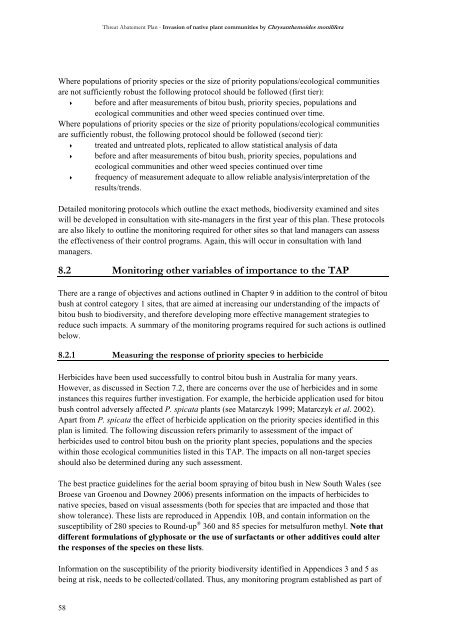NSW Bitou Bush Threat Abatement Plan - Department of ...
NSW Bitou Bush Threat Abatement Plan - Department of ...
NSW Bitou Bush Threat Abatement Plan - Department of ...
Create successful ePaper yourself
Turn your PDF publications into a flip-book with our unique Google optimized e-Paper software.
58<br />
<strong>Threat</strong> <strong>Abatement</strong> <strong>Plan</strong> - Invasion <strong>of</strong> native plant communities by Chrysanthemoides monilifera<br />
Where populations <strong>of</strong> priority species or the size <strong>of</strong> priority populations/ecological communities<br />
are not sufficiently robust the following protocol should be followed (first tier):<br />
< before and after measurements <strong>of</strong> bitou bush, priority species, populations and<br />
ecological communities and other weed species continued over time.<br />
Where populations <strong>of</strong> priority species or the size <strong>of</strong> priority populations/ecological communities<br />
are sufficiently robust, the following protocol should be followed (second tier):<br />
< treated and untreated plots, replicated to allow statistical analysis <strong>of</strong> data<br />
< before and after measurements <strong>of</strong> bitou bush, priority species, populations and<br />
ecological communities and other weed species continued over time<br />
< frequency <strong>of</strong> measurement adequate to allow reliable analysis/interpretation <strong>of</strong> the<br />
results/trends.<br />
Detailed monitoring protocols which outline the exact methods, biodiversity examined and sites<br />
will be developed in consultation with site-managers in the first year <strong>of</strong> this plan. These protocols<br />
are also likely to outline the monitoring required for other sites so that land managers can assess<br />
the effectiveness <strong>of</strong> their control programs. Again, this will occur in consultation with land<br />
managers.<br />
8.2 Monitoring other variables <strong>of</strong> importance to the TAP<br />
There are a range <strong>of</strong> objectives and actions outlined in Chapter 9 in addition to the control <strong>of</strong> bitou<br />
bush at control category 1 sites, that are aimed at increasing our understanding <strong>of</strong> the impacts <strong>of</strong><br />
bitou bush to biodiversity, and therefore developing more effective management strategies to<br />
reduce such impacts. A summary <strong>of</strong> the monitoring programs required for such actions is outlined<br />
below.<br />
8.2.1 Measuring the response <strong>of</strong> priority species to herbicide<br />
Herbicides have been used successfully to control bitou bush in Australia for many years.<br />
However, as discussed in Section 7.2, there are concerns over the use <strong>of</strong> herbicides and in some<br />
instances this requires further investigation. For example, the herbicide application used for bitou<br />
bush control adversely affected P. spicata plants (see Matarczyk 1999; Matarczyk et al. 2002).<br />
Apart from P. spicata the effect <strong>of</strong> herbicide application on the priority species identified in this<br />
plan is limited. The following discussion refers primarily to assessment <strong>of</strong> the impact <strong>of</strong><br />
herbicides used to control bitou bush on the priority plant species, populations and the species<br />
within those ecological communities listed in this TAP. The impacts on all non-target species<br />
should also be determined during any such assessment.<br />
The best practice guidelines for the aerial boom spraying <strong>of</strong> bitou bush in New South Wales (see<br />
Broese van Groenou and Downey 2006) presents information on the impacts <strong>of</strong> herbicides to<br />
native species, based on visual assessments (both for species that are impacted and those that<br />
show tolerance). These lists are reproduced in Appendix 10B, and contain information on the<br />
susceptibility <strong>of</strong> 280 species to Round-up ® 360 and 85 species for metsulfuron methyl. Note that<br />
different formulations <strong>of</strong> glyphosate or the use <strong>of</strong> surfactants or other additives could alter<br />
the responses <strong>of</strong> the species on these lists.<br />
Information on the susceptibility <strong>of</strong> the priority biodiversity identified in Appendices 3 and 5 as<br />
being at risk, needs to be collected/collated. Thus, any monitoring program established as part <strong>of</strong>
















